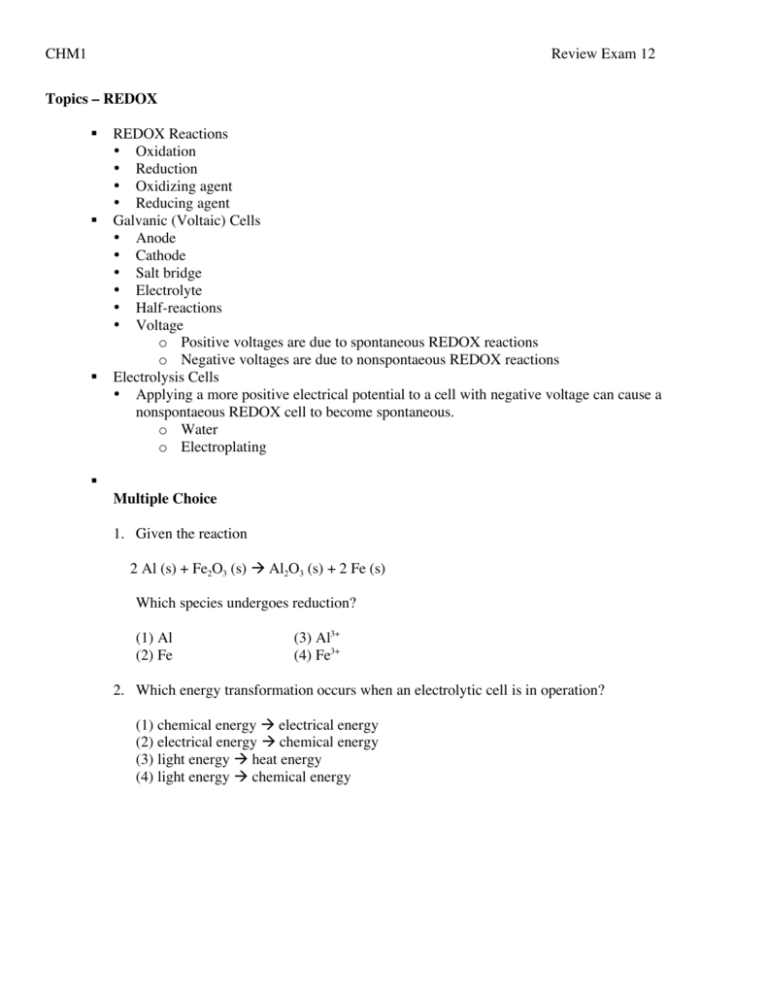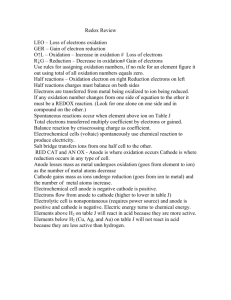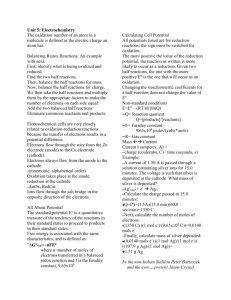CHM1 Review Exam 12 Topics – REDOX REDOX Reactions
advertisement

CHM1 Review Exam 12 Topics – REDOX REDOX Reactions • Oxidation • Reduction • Oxidizing agent • Reducing agent Galvanic (Voltaic) Cells • Anode • Cathode • Salt bridge • Electrolyte • Half-reactions • Voltage o Positive voltages are due to spontaneous REDOX reactions o Negative voltages are due to nonspontaeous REDOX reactions Electrolysis Cells • Applying a more positive electrical potential to a cell with negative voltage can cause a nonspontaeous REDOX cell to become spontaneous. o Water o Electroplating Multiple Choice 1. Given the reaction 2 Al (s) + Fe2O3 (s) Al2O3 (s) + 2 Fe (s) Which species undergoes reduction? (1) Al (2) Fe (3) Al3+ (4) Fe3+ 2. Which energy transformation occurs when an electrolytic cell is in operation? (1) chemical energy electrical energy (2) electrical energy chemical energy (3) light energy heat energy (4) light energy chemical energy CHM1 Review for Exam 10 3. Given the reaction Mg (s) + 2 AgNO3 (aq) Mg(NO3)2 (aq) + 2 Ag (s) Which type of reaction is a REDOX reaction? (1) single replacement (2) double replacement 4. (3) synthesis (4) decomposition Which equation shows conservation of both mass and charge? (1) Cl2 + Br- Cl- + Br2 (2) Cu + 2 Ag+ Cu2+ + Ag (3) Zn + Cr3+ Zn2+ + Cr (4) Ni + Pb2+ Ni2+ + Pb 5. The diagram below shows a key being plated with copper in an electrolytic cell. Given the reduction reaction for this cell: Cu2+ (aq) + 2 e- Cu (s) This reduction occurs at (1) A, which is the anode (2) A, which is the cathode (3) B, which is the anode (4) B, which is the cathode 6. What is conserved during a chemical reaction? (1) mass, only (2) charge, only (3) both mass and charge (4) neither mass nor charge CHM1 Review for Exam 10 7. Which type of reaction occurs when nonmetal atoms become negative nonmetal ions? (1) oxidation (2) reduction (3) substitution (4) condensation 8. Given the reaction: Zn (s) + 2 HCl (aq) ZnCl2 (aq) + H2 Which statement correctly describes what occurs when this reaction takes place in a closed system? (1) Atoms of Zn (s) lose electrons and are oxidized. (2) Atoms of Zn (s) lose electrons and are reduced. (3) There is a net loss of mass. (4) There is a net gain of mass. 9. A voltaic (Galvanic) cell differs from an electrolytic cell in that in a voltaic cell (1) energy is produced when the reaction occurs (2) energy is required for the reaction to occur (3) both oxidation and reduction occur (4) neither oxidation nor reduction occur 10. What is the purpose of the salt bridge in a voltaic cell? (1) It blocks the flow of electrons (2) It blocks the flow of positive and negative ions. (3) It is a path for the flow of electrons. (4) It is a path for the flow of positive and negative ions. 11. How many electrons must be removed from elemental hydrogen (H2) to produce two moles of hydrogen ions (H+) in an aqueous solution (6.02 x 1023 electrons per 1 mole)? (1) 6.02 x 1023 (2) 12.04 x 1023 (3) 3.01 x 1023 (4) none of the above 12. Which statement is true for any electrochemical cell? (1) Oxidation occurs at the anode, only. (2) Reduction occurs at the anode, only. (3) Oxidation occurs at both the anode and the cathode. (4) Reduction occurs at both the anode and the cathode. CHM1 Review for Exam 10 13. Given the equation: 2 Al + 3 Cu2+ 2 Al3+ + 3 Cu The reduction half reaction is (1) Al Al3+ + 3 e- (3) Al + 3 e- Al3+ (2) Cu2+ + 2 e- Cu (4) Cu2+ Cu + 2 e14. A diagram of a electrochemical cell and an equation are shown below. When the switch is closed, the electrons will flow from (1) the Pb (s) to the Cu (s) (2) the Cu (s) to the Pb (s) (3) the Pb2+ (aq) to the Pb (s) (4) the Cu2+ (aq) to the Cu (s) 15. When a neutral atom undergoes oxidation, the atom’s oxidation state (1) decreases as it gains electrons (2) decreases as it loses electrons (3) increases as it gains electrons (4) increases as it loses electrons 16. Given the equation: C (s) + H2O (g) CO (g) + H2 (g) Which species undergoes reduction? (1) C (s) (2) H+ (3) C2+ (4) H2 (g) CHM1 Review for Exam 10 17. Given: Mg (s) + 2 H+ (aq) + 2 Cl- (aq) --> Mg2+ (aq) + 2 Cl- (aq) + H2 (g) Which species undergoes oxidation? (1) Mg (s) (2) H+ (aq) (3) Cl- (aq) (4) H2 (g) 18. Which particles are gained and lost during a redox reaction? (1) electrons (2) protons (3) neutrons (4) positrons 19. What is the oxidation number of chromium in K2Cr2O7? (1) 12+ (2) 2+ (3) 3+ (4) 6+ 20. What is the oxidation number of manganese in MnO4-? (1) -1 (2) 4- (3) 5+ (4) 7+ CHM1 Review for Exam 10 Short Answer Base your answers to the following questions on the diagram of the voltaic cell below. 21. When the switch is closed, in which half-cell does oxidation occur? 22. When the switch is closed, state the direction that electrons will flow through the wire. 23. Based on the given equation, write the balanced half-reaction that occurs in half-cell 1. CHM1 Review for Exam 10 24. If, Ag+ (aq) + e- Ag (s), E° = +0.799 V and, Zn2+ (aq) + 2 e- Zn (s), E° = –0.63 V, what is the standard potential of the cell shown below. Explain. KNO3 Ag (s) Salt bridge Ag+ (aq) Zn (s) Zn2+ (aq) 2 Ag+ (aq) + Zn (s) 2 Ag (s) + Zn2+ (aq) 25. Define the following (a) Oxidation (b) oxidizing agent (c) salt bridge (d) anode (e) electrolysis CHM1 Review for Exam 10 Answers 1. 4 2. 2 3. 1 4. 4 5. 2 6. 3 7. 2 8. 1 9. 1 10. 4 11. 2 12. 1 13. 2 14. 1 15. 4 16. 2 17. 1 18. 1 19. 4 20. 4 21. Oxidation occurs at the anode, which in this case is the compartment containing the Pb electrode. 22. FAT CAT from the anode to the cathode, or from the Pb electrode to the Ag electrode. 23. Pb (s) Pb2+ (aq) + 2 e24. ince the Ag+ is reduced with a potential of +0.799 V and the Zn is oxidized with a potential of +0.63 V the overall REDOX potential is 1.43 V. The reaction is spontaneous. 25. (a) oxidation is the lose of electrons; (b) the oxidizing agent is the species that gets reduced; (c) The salt bridge conducts ions between the anode and cathode; (d) The anode is the electrode where oxidation occurs; (e) electrolysis is a redox process in which electrical potential energey is used to cause a nonspontaneous redox reaction to become spontaneous.







